The idea here is to summarize my understanding of the book. However, first of all, an important observation to pay attention to throughout this summary is that the authors are extremely focused on customer service centers, that is, they are always associating the term “Customer Service” with what here in our region we have such as customer service, after-sales, customer support, especially those via phone or chat through an attendant.
Therefore, their study and advocacy do not cover the customer’s full journey with brands, but rather this specific point in the journey. This is very clear in the title of the last chapter “Effort Beyond the Contact Center“, where, yes, he demonstrates that the philosophy and methodology advocated in the book can make sense at other touchpoints in the customer journey.
And it is for this reason that the CES (Customer Effort Score), an indicator created by the authors, is very appropriate for this moment in the customer journey and less for other points of contact or for a more comprehensive view of customer loyalty/loyalty with the brand.
Having clarified this point, you will have a reading of the rest of this content with an unbiased view, avoiding thinking that this material (indicator) would have great application in all areas of your business.
Does a surprising experience build customer loyalty?
The authors believe (they bring numbers and graphs that show) that customer loyalty is much more associated with a low- or no-friction experience than with an experience that positively surprises the customer in the service channels.
Important questions used by the authors for this awareness were:
- Which companies are you a customer of because of the exceptional customer service provided by them? (Remembering that customer service is after-sales service. A good example is the calls we receive to solve a problem with our telephone and internet operator.)
- Which companies have you stopped being a customer and refuse to do business again due to the bad experience they offered you? (The authors argue here that you will have an easier time remembering companies that fit question 2 than question 1.)
Differentiating Yourself With Kindness
With the advancement of technology, the life cycle of products is increasingly accelerated, that is, “shortened”. Therefore, many companies that innovate in their products soon realize that they were quickly copied and, therefore, one of their great differentials can be customer service. Especially because this is what the market has been constantly preaching.
Only 20% of customers of major brands perceive differentials between them:
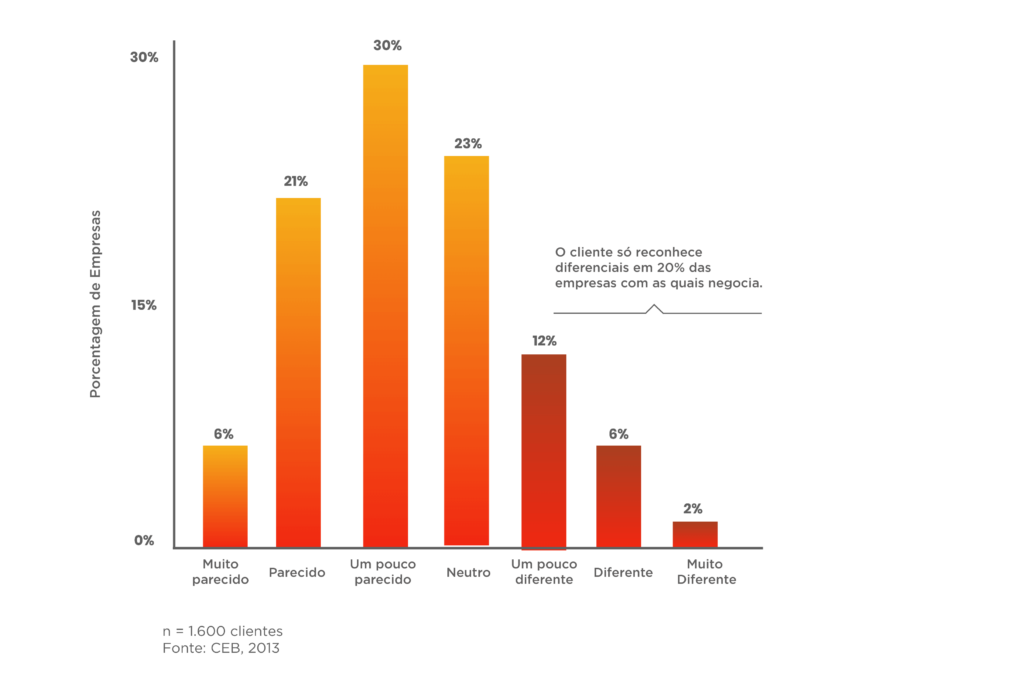
Important questions
- How important is customer service to fostering customer loyalty?
Everyone seems to believe that customer service is everything, but how? - What are the actions that customer service can take to increase loyalty?
Many companies seek to delight their customers to build their loyalty, but fail to consistently highlight their results. - How can customer service improve loyalty while also reducing operational costs?
Doing more with less is what is expected of any great business plan today. So, how to delight customers with few resources?
The methodology of the CEB study
Using the base of 400 companies from one of the largest customer service networks in the world (The Customer Contact Leadership Council), the CEB team interviewed more than 97,000 people who had recently received customer service to understand what most impacted their customer service loyalty.
This study began with questions about:
- Experience they had with the attendants;
- How exhausting it was for them, including the number of steps it took to solve their problems;
- The company’s ability to deliver an incredible experience to its customers.
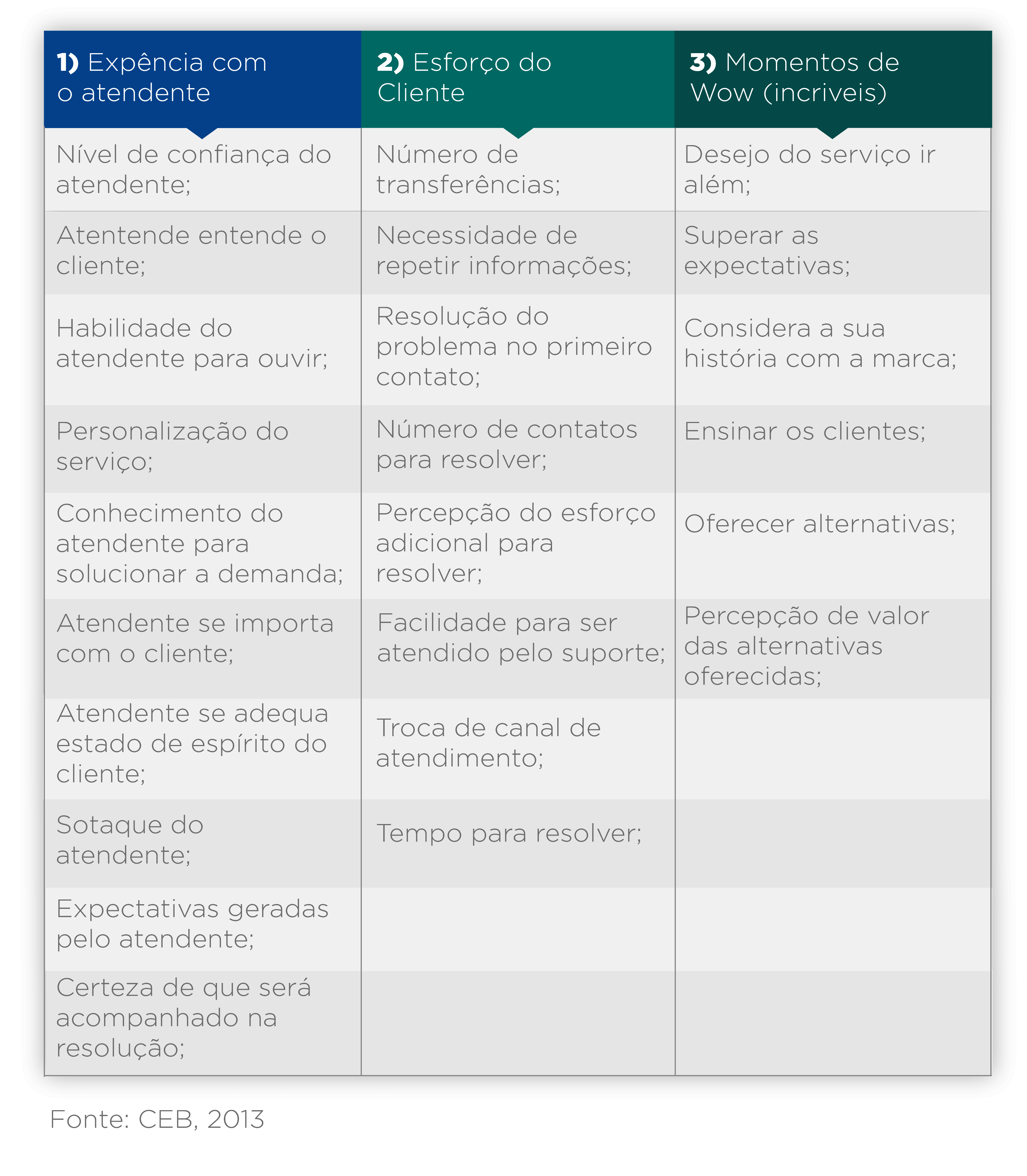
In this study, all these items could be segregated considering demography and ethnography.
Popular wisdom
Before going into the results of the study, the authors emphasized what popular wisdom preaches. They confirmed this through research.
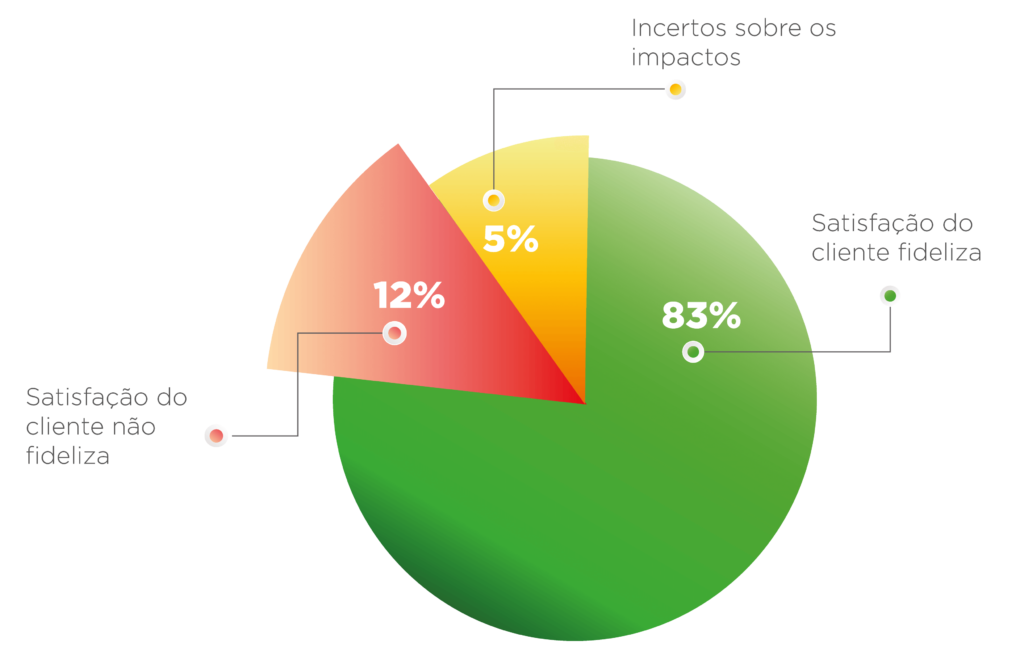
Graphically demonstrating, according to the expectation of this 83%, this would be the impact of customer satisfaction with customer service on loyalty:
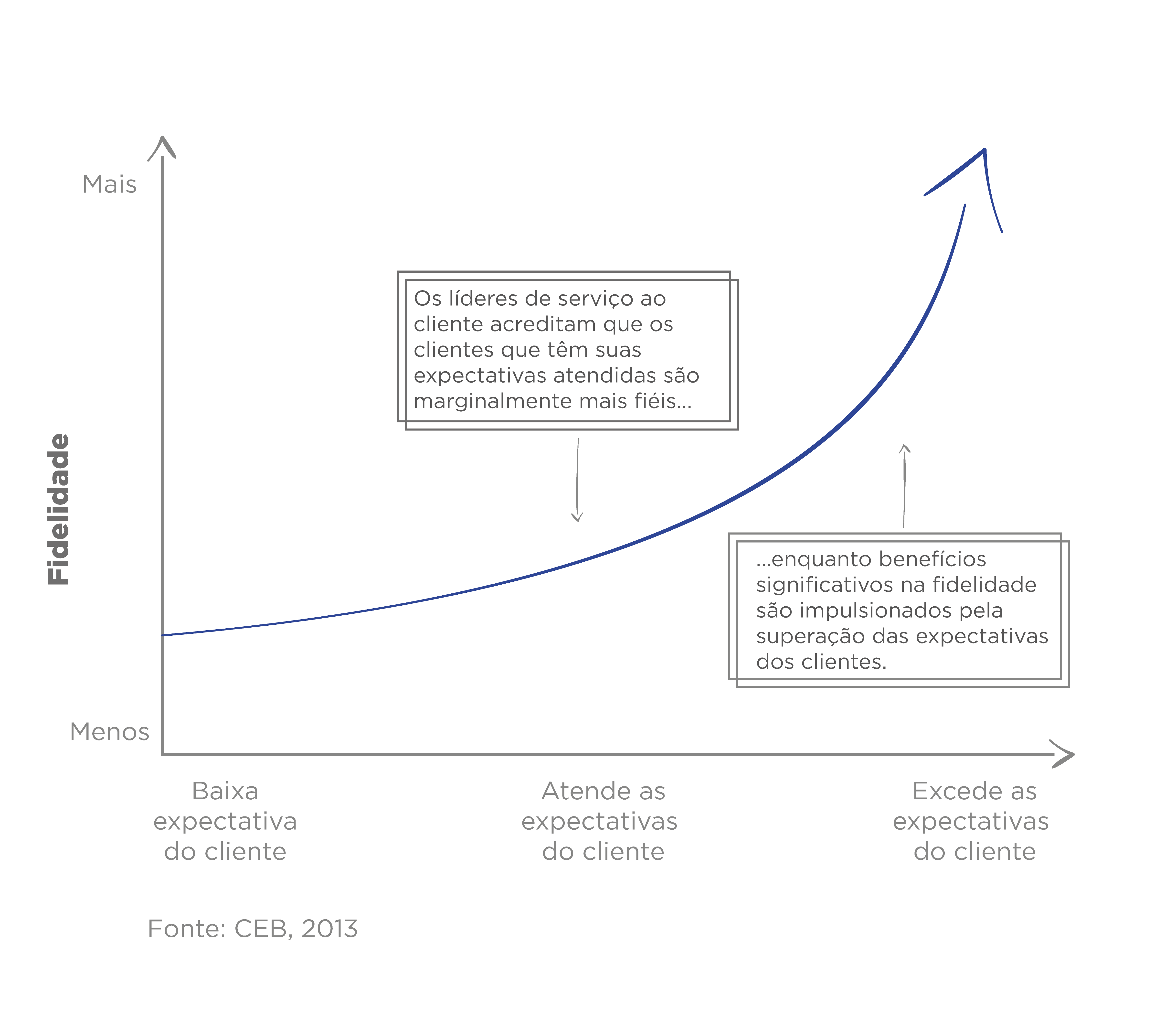
In short, customer service below expectations generates low loyalty, while exceeding customer expectations generates high loyalty rates.
However, we have:
Discovery No. 1
A strategy of exceeding expectations in customer service/support does not pay for itself.
Contrary to popular wisdom, when analyzing the data of the 97,000 respondents, it was found that there is practically no difference between simply meeting customer expectations and exceeding them.

According to the data and verbatims collected, customers would not be looking for anything special, they do not want to be surprised, but rather to have their problems quickly solved.
Therefore, all the investment that is made to exceed expectations would be a waste.
The author challenges managers working at companies that say they exceed customer expectations to answer the following questions with a “YES”:
- Do your company’s customer service leaders reach out to the CEO or CFO to request additional resources and support their ability to delight the customer across their service channels?
- Does your company empower agents to do their best to exceed customer expectations, regardless of cost?
- If your product or service does not meet the customer’s expectations, would you allow them to choose some replacement or alternative outside the warranty period and perhaps even beyond the value of the original product?
- Have you removed all productivity measures (such as call duration, also known as FCR – First Call Resolution) from the service team’s indicators, so that they can focus all their energy on delighting customers and exceeding their expectations?
Discovery No. 2
Customer service satisfaction has nothing to do with loyalty.
The survey of 97,000 customers revealed a relationship between customer satisfaction with service and loyalty of only 0.13 on a scale of 0 to 100.
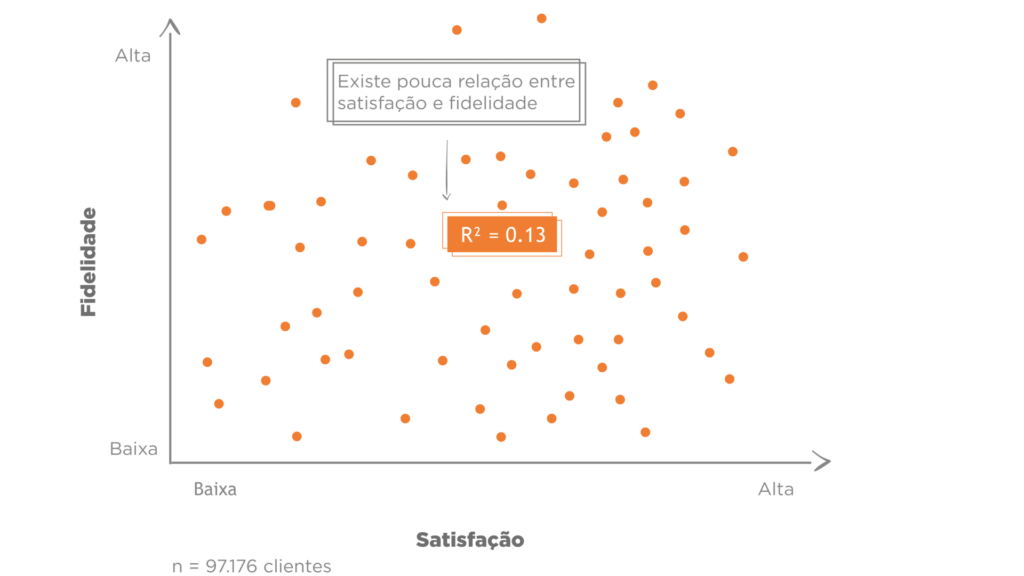
Although it may seem strange, 20% of customers who declared satisfaction with the support offered also reported that they intended to leave the brand and buy from its competitors. They said they were satisfied, but that they would not be loyal to the brand just because of this satisfaction. On the other hand, 28% of customers reported being dissatisfied but loyal to brands.
The authors want to prove that CSAT, an indicator of customer service satisfaction, has no relation to customer loyalty. This seems obvious, and it really shouldn’t be expected that only satisfaction with the service would generate loyalty, after all, when CSAT is applied, the person is evaluating the attendant and not satisfaction with their entire journey.
People, when evaluating the attendant, are often able to separate the company’s high-friction processes from the good professional who served them. Perhaps the authors lacked the sensitivity to consider that loyalty involves the entire journey and not just a point of contact.
Discovery No. 3
Customer service tends more to “de-loyalty” rather than loyalty.
According to the survey results, customer service is four (4) times more likely to “de-loyalty” than to build customer loyalty.
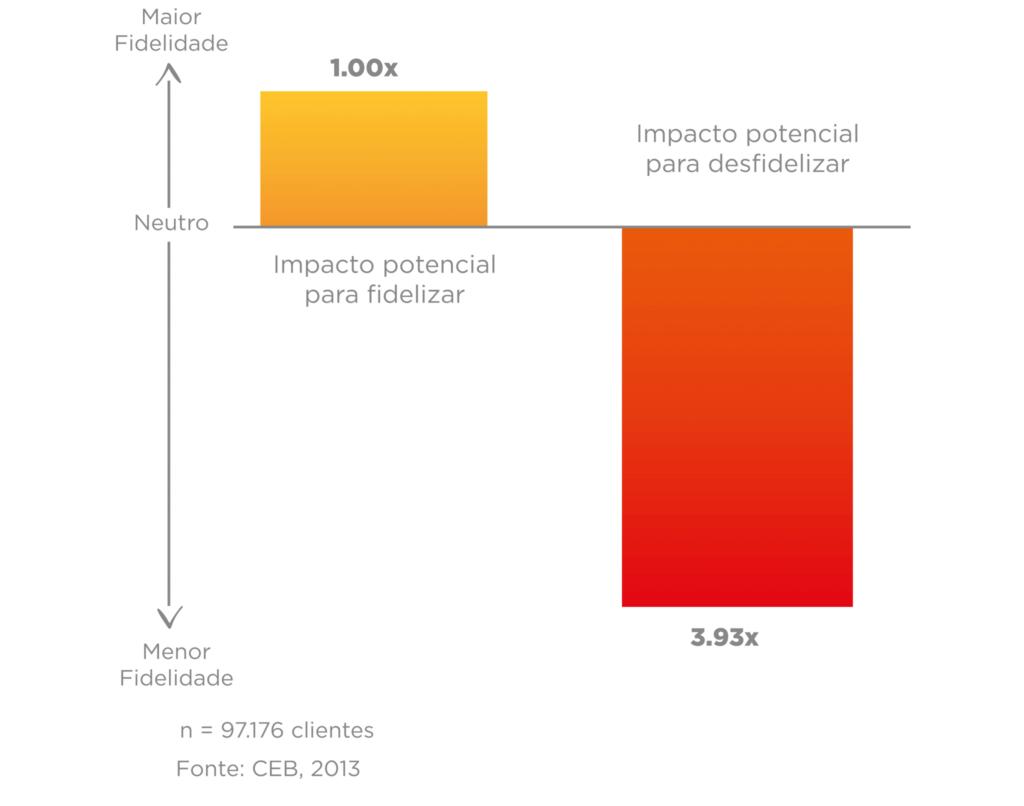
Remember that the customer only seeks customer service when something has already gone wrong. Therefore, the responsibility of the customer service is to solve the customer’s problem and put him in a situation of normality again.
The problem is that, most of the time, companies have great difficulties in meeting customer expectations in this service channel, so they end up leading customers to fury and, consequently, to non-loyalty.
The dissatisfied, as defended in all the literature of the segment, rush to speak ill of the company after these bad experiences.
They also collected very interesting data on the impact on customer loyalty satisfied with products vs. satisfied customers with experience.
Product:
- 71% of customers who like a product talk about it with people close to them;
- 32% of customers who don’t like a product talk about it with people close to them.
Customer Service:
- 25% of customers who have had a good experience with customer service talk about it with people close to them;
- 65% of customers who haven’t had a good customer service experience talk about it with people close to them.
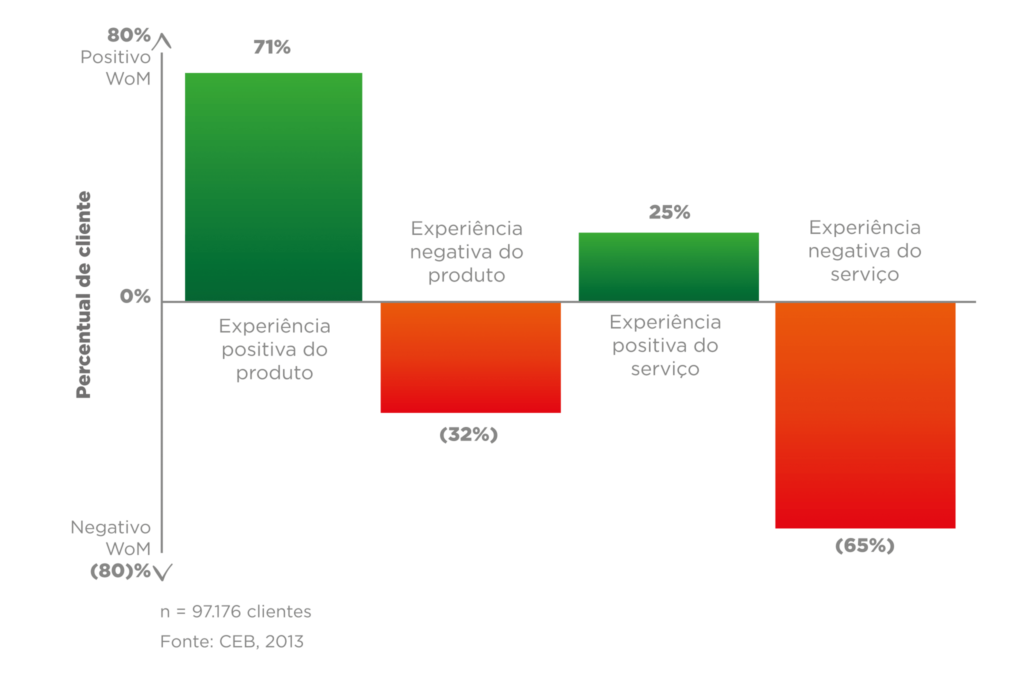
Through some examples, the book reminds us that a service experience involves personal treatment and, when we consider a negative experience, this is because we understand that we are being disrespected.
When this happens, one of the first instincts of the person is to seek empathy from his friends and relatives, so he tells the story where he is the victim and was disrespected, that is, he is intelligent, but the service treated him like an idiot and etc..
The research showed:
- A good customer service experience generates 45% of customers talking about it to one (1) to three (3) people;
- A bad customer service experience generates 48% of customers talking about it to more than ten (10) people.

With the creation of social networks, here in Brazil we even have the existence of a specific channel for complaints (Reclame Aqui), it is evident that this 48% can gain a totally disproportionate scale between positive and negative cases.
What makes you stop doing business with a company?
Almost all of us have a company that we avoid doing business as much as possible, usually this condition came after some bad experience that the brand offered us during the attempt for you to try to solve a problem with the customer service attendant.
In short, we choose companies because of their products and prices, but we usually leave them for their failures in customer service.
Discovery No. 4
The key to mitigating “de-loyalty” is reducing customer efforts.
Analyzing the data to understand what drives customers to be more or less loyal, the authors arrived at the graph below:
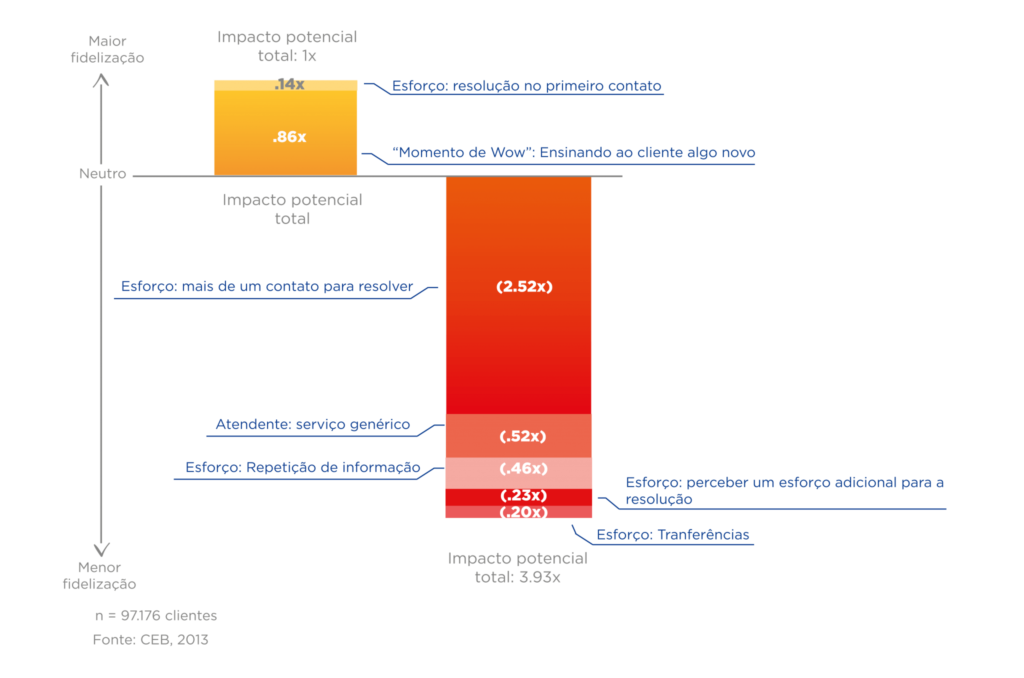
Four (4) of the five (5) reasons that make the customer less loyal are related to the customer’s effort.
First Call Resolution vs. Next Issue Avoidance
From that point on, the authors began their criticism of the FCR (Firs Call Resolution) indicator, or first contact resolution rate. They allege that, due to the FCR, the service ends up being limited to solving what the customer asked for and does not anticipate future problems associated with that request and, thus, the customer often needs to return his call when he realizes that the solution to one problem caused another.
Based on this, they start to suggest a new indicator called Next Issue Avoidance, which would be a rate of elimination of next problems.
Generic service
The next big villain for non-loyalty through customer service is generic service.
Generic service occurs when the customer feels that he is treated as a number, without any personalization to his service, when he hears the attendant simply coldly reciting that that condition is stated in the contract, or even when the attendant utters phrases of gratitude for his loyalty without any emotion involved.
Repetition of information
Having to repeat registration information and tell your problem to numerous attendants is another item that generates additional effort and customer dissatisfaction.
Perceived additional effort to solve the problem
Agent communication can generate a perception of effort to solve the problem and, for this reason, companies should focus on improving the way their agents communicate with their customers.
In other words, there are many ways to say the same thing. Some tend to improve customers’ perception of effort, while others tend to worsen this perception.
Exemplifying:
You arrive at the airport and find that your 7:30 a.m. flight has been canceled.
When talking to the attendant, he tells you:
Option 1:
“I’m sorry for the inconvenience with your flight. We can reschedule for today at 9 pm.”
Option 2:
“I’m sorry for the inconvenience with your flight. I know we managed to fit you in on a flight for tomorrow at 9 a.m., however, let me see if I can help you with any fittings later today.”
A short pause and then:
“I have good news, I managed to fit you on a flight for 9 pm. I understand that you will have to lose a few hours, but at least you will be able to reach your destination today.”
Transfers
Transfers between attendants and also the need to change the service channel (entering the website and finding out that you need to call the center, for example) generate frustration.
Although this is the element with the least weight among the five (5) reasons, in the authors’ view, it is the one that has the greatest potential to change the customer service as it is today through the web site with a good self-service .
Resemindotudo
What the book argues, simplifying as much as possible, is that customer service should mitigate customer “disloyalty” by reducing customer efforts.
Changing the fidelity curve
As illustrated below, the authors preach that it is incorrect to try to increase the total loyalty of their customers through an above-expected experience in their customer service.
On the other hand, it is entirely feasible to reduce “disloyalty” through a customer service that demands less effort from customers.

It also summarizes in three (3) points the reasons why customer delight does not work in customer service:
- Exceeding customer expectations in the SAC is rare, and when this happens it does not make customers even more loyal for simply having met their expectations;
- It doesn’t work because customer service interactions are 4 times more likely to “disloyalty” than to build loyalty;
- It doesn’t work because optimizing to exceed expectations doesn’t focus resources, investments, metrics, and incentives to reduce customer efforts, which is, in fact, the main reason for “de-loyalty.”
Therefore, do what you have to do to get your customers back to their lives as quickly as possible, with efficiency and the confidence that their problems have really been fixed. Reduce your customer’s efforts!
The four principles of low-effort service
In addition to the above introduction, the CEB team embarked on studies on customer efforts from several years and diverse sources. They generated several additional studies and quantitative studies fully immersing themselves in the nature of the clients’ efforts.
They also spoke with hundreds of leaders to identify innovative practices to reduce customer efforts.
- Companies that offer low effort to customers minimize the need to switch channels through a good experience on their digital self-service channels;
- When the customer is forced to call the company because they have not found a solution in self-service, these companies prepare their attendants to go beyond the basic service and anticipate possible future problems, preventing the customer from having to return the call;
- Companies prepare their agents to change the perception of their customers through communication.
They devise service tactics and give agents permission to manage customer interactions;
- They empower their agents to deliver a low-effort experience with incentive plans that they value through indicators that go beyond speed and efficiency. They remove the culture of timers and checklists and “focus” on giving greater autonomy and opportunity for their attendants to exercise a greater degree of judgment about their services. They understand that, in order to have a higher quality in the experience delivered, they need to give greater control to those responsible for these deliveries.
By following these four steps of innovative practices to reduce customer efforts, the company will certainly obtain good results.









